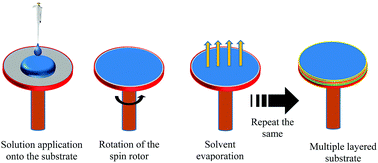Wet-process enables organic light-emitting diodes (OLEDs) to be made cost-effectively via a continuous process, such as roll-to-roll manufacturing. Initially, wet-process based OLEDs used to be fabricated with polymer-based emitters and/or host materials. However, small molecules that can be processed using a wet-process are more promising for commercialization due to easier control over their molecular weight, purification, solution viscosity, layer thickness, and uniformity. We have hence reviewed herein (i) what constitutes the essential materials for wet-process feasible OLEDs, (ii) applicable wet-process technologies, and (iii) reported wet-processed mono- and polychromatic OLED devices with sound efficiency performance. And last, but not least, we have pointed out the most critical challenges that wet-processed electronics including OLED must face before gaining sufficient ground for competition and turning into disruptive technology. These include issues such as multiple-layer feasibility, film integrity, film forming capability, and device lifetime.

